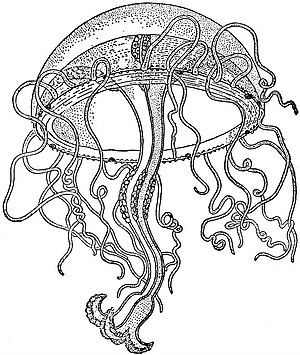Stage 4, seen in Plumularidae.—The generative elements are
produced in structures termed corbulae, formed by reduction
and modification of branches of the colony. Each corbula
contains a central row of blastostyles enclosed and protected
by lateral rows of branches representing stunted buds (Allman [1],
p. 66, fig. 30).
The Leptomedusa in form is generally shallow, more or less saucer-like, with velum less developed than in Anthomedusae (fig. 55). The characteristic sense-organs are ectodermal otocysts, absent, however, in some genera, in which case cordyli may replace them. When otocysts are present, they are at least eight in number, situated adradially, but are often very numerous. The cordyli are scattered on the ring-canal. Ocelli, if present, are borne on the tentacle-bulbs. The tentacles are usually hollow, rarely solid (Obelia). In number they are rarely less than four, but in Dissonema there are only two. Primitively there are four perradial tentacles, to which may be added four interradial, or they may become very numerous and are then scattered evenly round the margin, never arranged in tufts or clusters. In addition to tentacles, there may be marginal cirri (Laodice) with a solid endodermal axis, spirally coiled, very contractile, and bearing a terminal battery of nematocysts. The gonads are developed typically beneath the radial canals or below the stomach or its pouches, often stretching as long bands on to the base of the manubrium. In Octorchidae (fig. 58) each such band is interrupted, forming one mass at the base of the manubrium and another below the radial canal in each radius, in all eight separate gonad-masses, as the name implies. In some Leptomedusae excretory “marginal tubercles” are developed on the ring-canal.
Classification.—As in the Gymnoblastea, the difficulty of uniting the hydroid and medusan systems into one scheme of classification is very great in the present state of our knowledge. In a great many Leptomedusae the hydroid stage is as yet unknown, and it is by no means certain even that they possess one. It is quite possible that some of these medusae will be found to be truly hypogenetic, that is to say, with a life-cycle secondarily simplified by suppression of metagenesis. At present, ten recent and one extinct family of Calyptoblastea (Leptomedusae) may be recognized provisionally:
1. Eucopidae (figs. 55, 59).—Trophosome with stalked hydrothecae; gonosome, free medusae with otocysts and four, rarely six or eight, unbranched radial canals. Two of the commonest British hydroids belong to this family, Obelia and Clytia. Obelia forms numerous polyserial stems of the characteristic zigzag pattern growing up from a creeping basal stolon, and buds the medusa of the same name. In Clytia the polyps arise singly from the stolon, and the medusa is known as Phialidium (fig. 59).
2. Aequoridae.—Trophosome only known in one genus (Polycanna), and similar to the preceding; gonosome, free medusae with otocysts and with at least eight radial canals, often a hundred or more, simple or branched. Aequorea is a common medusa.
3. Thaumantidae.—Trophosome only known in one genus (Thaumantias), similar to that of the Eucopidae; gonosome, free medusae with otocysts inconspicuous or absent, with usually four, sometimes eight, rarely more than eight, radial canals, simple and unbranched, along which the gonads are developed, with numerous tentacles bearing ocelli and with marginal sense-clubs. Laodice and Thaumantias are representative genera.
4. Berenicidae.—Trophosome unknown; gonosome, free medusae, with four or six radial canals, bearing the gonads, with numerous tentacles, between which occur sense-clubs, without otocysts. Berenice, Staurodiscus, &c.

|
|
After Haeckel, System der Medusen, by permission of Gustav Fischer. |
| Fig. 58.—Octorchandra canariensis, from life. |
5. Polyorchidae.—Trophosome unknown; gonosome, free medusae of deep form, with radial canals branched in a feathery manner, and bearing gonads on the main canal, but not on the branches, with numerous hollow tentacles bearing ocelli, and without otocysts. Polyorchis, Spirocodon.
6. Campanularidae.--Trophosome as in Eucopidae; gonosome, sessile gonophores. Many common or well-known genera belong here, such as Halecium, Campanularia, Gonothyraea, &c.
7. Lafoëidae.—Trophosome as in the preceding; gonosome, free medusae or gonophores, the medusae with large open otocysts. The hydroid genus Lafoëa is remarkable for producing gonothecae on the hydrorhiza, each containing a blastostyle which bears a single gonophore; this portion of the colony was formerly regarded as an independent parasitic hydroid, and was named Coppinia. Medusan genera are Mitrocoma, Halopsis, Tiaropsis (fig. 29, &c.).
(So far as the characters of the trophosome are concerned, the seven preceding families are scarcely distinguishable, and they form a section apart, contrasting sharply with the families next to be mentioned, in none of which are free medusae liberated from the colony, so that only the characters of the trophosome need be considered.)
8. Sertularidae.—Hydrothecae sessile, biserial, alternating or opposite on the stem. Sertularia and Sertularella are two very common genera of this family.
9. Plumularidae.—Hydrothecae sessile, biserial on the main stem, uniserial on the lateral branches or pinnules, which give the colony its characteristic feathery form; with nematophores. A very abundant and prolific family; well-known British genera are Plumularia, Antennularia and Aglaophenia.
10. Hydroceratinidae.—This family contains the single Australian species Clathrozoon wilsoni Spencer, in which a massive hydrorhiza


